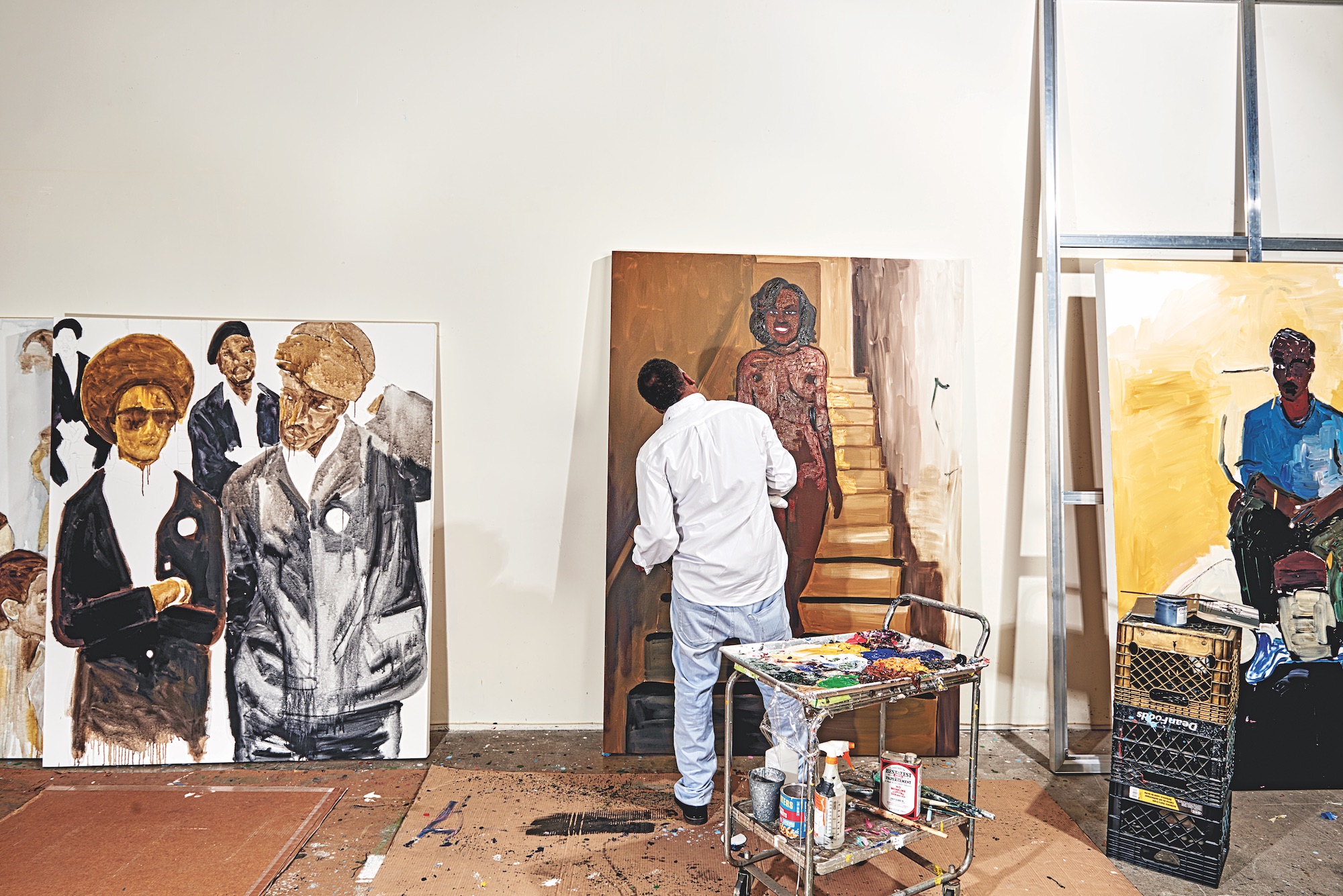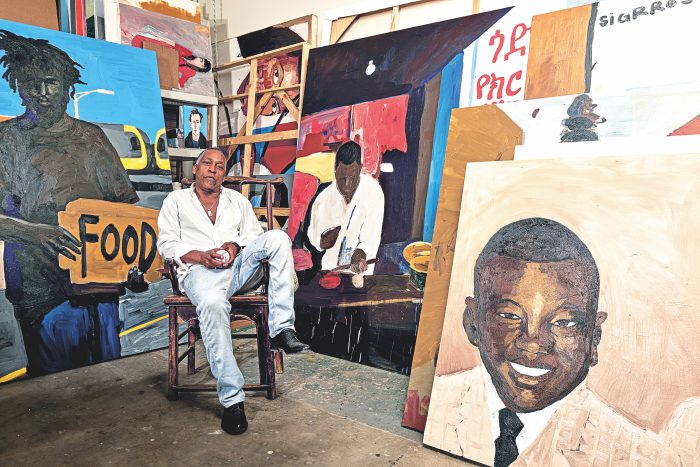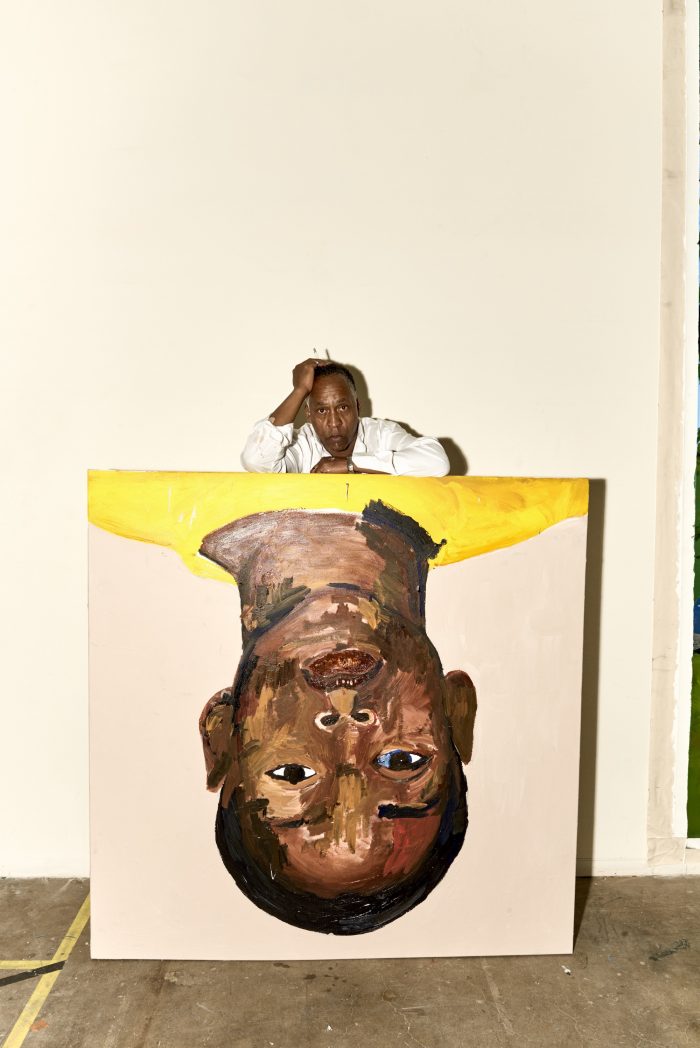
A quarter century ago Henry Taylor was working as a psychiatric technician painting his schizophrenic and bipolar patients by day and making a name for himself in the Los Angeles art world—hawking works on cigarette packs and cereal boxes—by night. In the ensuing decades, the man once known simply as “Chinatown” (after the neighborhood he long inhabited) has earned himself a spot in the upper echelons of the international art world, and his paintings of black—and white, and countless other lives—lives truly matter to people around the globe.
While he’s rated solo shows at Harlem’s Studio Museum and MoMA PS1, the past year elevated his career to new heights. After a stunning, immersive multimedia painting—and pot smoking—installation last year at the Culver City outpost of his primary dealer, Blum & Poe, Taylor made a splash at the Whitney Biennial with a room of epic paintings—opposite photos by his longtime friend and subject Deanna Lawson—that depicted everything from his family members to a Chicago barbecue chef to the police shooting of Philando Castile. (He even has a massive self-portrait of himself floating in a swimming pool gracing a building along the High Line.) Now, the 59 year-old, Ventura-born artist is set to make his solo debut, A Portrait Show, at Zurich’s Galerie Eva Presenhuber through July 22. So before he flew off to Switzerland to finish the show—and take a long-overdue European vacation—CULTURED asked LAXART Executive Director Hamza Walker to catch up with Taylor about the personal and political aspects of his practice, and was surprised to hear about the Van Gogh-inspired subjects he might tackle next.
Hamza Walker: You’re in the current Whitney Biennial, which has been marked by the controversy surrounding Dana Schutz’s painting of Emmett Till. You’ve done a painting of Philando Castile. The Schutz affair has been given a lot of air time. What was going through your mind when you painted Castile?
Henry Taylor: It was like, ‘Damn, another brother?’ Not that I was cataloging police shootings, you know, like say, that one painter Robert, who was painting pictures of Obama every day.
HW: Rob Pruitt?
HT: Yeah. I wasn’t trying to document every killing, but every once in awhile I can’t help but react or respond sometimes. It’s not always emotional. But then you just play the video and it’s like, ‘Wow. Wow. Wow.’ Like I said there was numerous killings of black people by police. I think the first painting of a police shooting victim I might have done was Sean Bell that was in the Studio Museum show like five years ago.
HW: Oh, that painting I don’t know.
HT: Yeah. Yeah. So I did the Sean Bell painting one day after I read about the incident, about his death. It resonated. I thought, ‘Damn, this guy liked the same things I did.’ I had a sort of connection with this guy. And when I painted that picture it meant something to me. You know, but the Castile painting, I really didn’t want to show it. I was just looking at newspapers—that used to be my source, sometimes I look at the Internet, but basically, being a journalism major, and then after being a journalist—I was in the habit of looking through the paper. And then when the curators came in they just wanted to see work and I happened to pull it out.
HW: You’ve got dozens of paintings in these stacks. So it was something they found?
HT: Yeah. It’s something that I was doing but I didn’t know why. I mean, I know why, it’s because here’s another black person and like damn, I was just, I was on autopilot or something. I’ve been listening to Bob Dylan since he wrote that song about George Jackson, and I remember asking who is this motherfucker writing about George Jackson?
HW: Yeah, yeah…
HT: O.K. So that song, I remember cutting that out of the newspaper. When we talk about Dana, I often think about Dylan.
HW: Yeah, right, right.
HT: And I said, ‘You know what, should Dylan not have written that song about George Jackson? Should Dylan not have written that song about Rubin ‘Hurricane’ Carter? Should Dylan not have written about Hattie Carroll?’ You know what I mean? So that’s what I asked myself when Dana did that painting of Emmett Till.
HW: Yeah.
HT: You know, people always talk about when is white America going to come to terms or whatever with their history. I don’t know, is that a start? When I was at the Whitney I talked to Dana. There was no controversy then. I was just happy to meet her—I like Dana! But, I think it has to do with sincerity. Like when I did Sean Bell, that fucking hit me. And maybe as a mother she really felt, you know, empathy for this person. You know?
HW: Yeah.
HT: But I know other white artists who don’t know who Emmett Till was.
HW: Right. Exactly.
HT: So, are we growing from this? Is it a step backward? I don’t know. They said the same thing about Spielberg when he did The Color Purple—‘We need a black director for this!’ I may have felt the same way a little bit, but you know what, William Styron wrote the story of Nat Turner. I never read a book about Nat Turner by a black man. I’m glad William Styron wrote that fucking book!
HW: Yeah.
HT: That’s how I feel. I mean, a lot of times having a black author doesn’t mean it’s a good representation.
HW: Right—or a better representation.
HT: Yeah. Yeah. I don’t want anybody telling me not to paint something about a white man. I don’t want anybody fucking telling me shit. Hell, I want to feel free when I’m on that fucking canvas. If nowhere else, I can go here and let it all out.
HW: Yeah, right or wrong. I’d like to take a few steps back and actually unpack some of the things you were saying about source material. I’m sure this comes up, in relationship to the way you work, but when do you know a painting finished?
HT: When they picked [the Philando Castile painting] I was like “Oh fuck!” And when they said they wanted it, I was like, let me redo this. I might have to start something new just to get excited. Sometimes I don’t know. You have to wait a while. I’m starting to be able to live with certain things. But sometimes I might have a hard time deciding something is finished. Sometimes you have to sit with shit and look at it for a while. I didn’t really see it quite like that. I don’t know if that really answers your question.
HW: Like the paintings might betray a lack of confidence, an uncertainty, and you’re not afraid to put that uncertainty on display. You make yourself vulnerable.

HT: It’s no longer about good and bad, it’s like sometimes you’re real accurate about the lines and you’re showing them everything that is academically correct and sometimes you have to own it all. Like I might not ever be Kobe, so just because you can’t be Kobe, you’re not going to play? I may not be the best, but I’ll do my best.
HW: The word that I used when I first came into the studio was promiscuity, and here we are looking at a painting that is quite direct in referencing Gerhard Richter’s Ema (Nude on a Staircase). And you mentioned how you might take things from newspaper sources and alter them. But could you talk a little bit about your relationship to your source material? It seems it’s the means to an end, but not an end in itself. It seems like you don’t really give a shit about whether or not people know how direct you’re being about referencing something. You don’t seem like you have to hide that or cover something like that up.
HT: You know, it’s funny, I don’t know if it’s as relevant, but when I think about the past, when someone would write about me and say ‘outsider artist,’ which means—we all know what that means—and so I think about that and I think about Gerhard Richter. I mean I’ve always had a history of art from an early age; my seventh grade teacher went to Berkeley, and studied art and English. So, although she might not have been into more contemporary artists, I was exposed. So that eliminates the whole ‘outsider’ thing. But that whole reference to Richter is just like, ‘Hey! I’m familiar.’ I’m painting black people…in Zurich. Sometimes I’ll bring certain characters with me because, you know, it’s almost like support.
HW: How do you think this will play itself out in Zurich? In other words, was this painting made with the understanding of having it be in another context?
HT: It’s like Kehinde [Wiley] doing these historical figures, and putting—it’s like black face, but it’s not really black face. It’s a way of letting people know, in case they’re wondering, I do open up books. You know what I’m saying? Maybe you can relate on this level. But really, it’s spontaneous. And it might even be a homage. Like this here, I didn’t know what I was going to do [points to an assemblage sculpture] with toilet paper rolls but I put them in a circular fashion. It’s a homage to David Hammons and me just having camaraderie with other artists. It’s like I’m doing a cover. It’s Jimi Hendrix doing “All Along The Watchtower.”
HW: Oh yeah, right.
HT: I’m doing a motherfucking cover, and I hope my version is pleasing. You know, I don’t know if that’s an academic answer, but it’s an honest answer.
HW: It’s an honest answer. I was wondering if you could talk about your reference points. Art historical references might be one thing, but newspaper sources in reference to current events, journalism, reportage; things that are of the moment, and I was wondering if you could talk about your role as a painter in this moment, of this moment. I mean, you mentioned you felt uneasy about Philando Castile, right? Where does that reluctance come from?
HT: Sometimes you want to put positive things out there. You know, and a lot of them were positive. But maybe it’s like a rapper writing about the projects and that’s his real life. I know this ain’t me, but if it affects me because I’m as vulnerable and it could be me. I don’t know if I was reluctant, but I just thought maybe this [painting] is too literal, but then I ended up changing the painting completely. And I said I’m going to do a different version. You know, because I didn’t want it to be as literal. I just wanted to soften it, but I don’t know if that’s weakening it. It’s still just a recollection.

HW: Could we talk a bit about how you might alter an image, about that process of bringing memory into it, a certain level of nostalgia. It seems like a lot of the paintings are autobiographical.
HT: Like you said, promiscuity. I think I just hunt and gather. I feel sort of voracious. I just think about my son, I have kids, and my parents are from the South, and I would hear things—my grandfather was shot and killed—so I’m just documenting things, and I’m saying, ‘Damn, this shit ain’t stopped.’ So I’m just shocked. Sometimes I just want to repress it and I never thought I’d have to tell my son, you know, ‘Well, son you were called a n—.’ There are certain things I endured that I didn’t think my son would have to endure. But we’re still having to go through these things, and I guess I’m just a little appalled that this shit is still happening. You know?
HW: And so that weighs on you.
HT: It fucking weighs on me. You know, I’ll never forget when the whole Rwanda thing was happening and I’ll never forget the newspaper story of a boy, there were two black kids, African kids, one walking his brother to school. I never will forget that image. I never painted that image, but I never will forget that image. You know, so I think it is the weight, and I just have to get it out, and I get it out, but then I don’t know what to do with it.
HW: I mean, I look over here at this painting, at the one that’s in progress, with the sign of ‘Don’t Run,’ and there’s a cop in a position where he seems like he’s pulling out his gun and you have a naked black figure running, but it’s the issue of the “Don’t Run,” and I was trying to explain that to people. Every black boy was told by his father not to run from the police because that gives them license to shoot you in the back if you run.
HT: I did that painting four years ago and I was probably reading about another incident, because like I said, with the new cell phone it’s like, ‘Damn, again? Again?’ Some things you just can’t suppress. You know what I mean? There are just certain things that are going to permeate your work.
HW: It’s never been a question with you, at least what I can gauge from your work, it’s always been figurative. It’s hopelessly ground in figuration, unquestioningly grounded in figuration. You either have a relationship or an interest in people, or not.
HT: Right.
HW: And I’m wondering if maybe you can talk about that since, especially in your years working in a mental institution.
HT: It has a lot to do with relationships.
HW: The canvas as a place for biography; the canvas as a place for history. The canvas as a place for people you just met.
HT: First of all, I love other people, I love to meet them, and the fact I can just paint them. Like Bill Johnson over there, you know, this is someone who rescued me. There’s a definite connection. He was a good friend of my dad’s, you know. Noah Davis. I was a close friend. What I see around me, brothers on the street.
HW: So you see yourself as a cipher? Like this stuff is coming through you.
HT: First, there’s a love of painting, and there’s my connection with people.
HW: Could you tell us about your relationship with Noah Davis? You know, I think it’s quite a beautiful and interesting moment, if we go back and look at the lineage of black artists, I’m thinking of Beauford Delaney and maybe Bob Thompson, and it’s interesting to think about black painters who were dealing with the figure, with both the figure and the narrative. Could you talk with me for a little bit with me about your relationship to Noah?
HT: We might have met in Miami at the “30 Americans” survey at the Rubell Family Collection. Then I saw a lot of him when we were back in L.A., and I saw a lot of his frustration as a young artist who was ambitious and smart and just so passionate about making art. There was just a camaraderie, a genuine friendship; we saw each other almost daily. I was concerned about the painting, but he was concerned about the market… I started to take the art world, I don’t want to say seriously, but I started to really look at it closer.
HW: Through him.
HT: Through him because of what was happening to him. You know, maybe it would have happened to me later, but if he wanted to vent, then vent. It was always legitimate, it wasn’t like whining, it was like things are fucked up, this is fucked up and I had to agree. I was oblivious to certain things because I was more content. But he was never content. Where others whined, he just said, ‘I’m going to change it.’ And I think I admired him for that, and that’s why I probably opened my gallery on Third Street, just to sort of step it up. I could do more. I mean, Theaster Gates does that for me, but sometimes I could just be a painter and live my life painting and not try to do anything else, but it’s just when I think about Schindler’s List—Oh, I could have done more! Maybe I could help someone else, instead of thinking about myself. So you know, it made me more altruistic or something.
HW: And I feel sometimes, you’re only as smart as your friends. You’re only as ambitious as your friends. You have them there to help you question yourself, and what’s your reach.
HT: I think I grew from that relationship more than any other relationship. I mean I know some successful artists, and Noah wasn’t that successful of an artist at that time, but fuck yeah I did. Fuck yeah I did.
HW: Right. It’s intuitive.
HT: You ask me these questions, and my head is spinning. I feel like, sometimes I could be Van Gogh painting a cornfield. Sometimes I just want to paint my momma. I might want to paint flowers, but I haven’t gotten there yet.










 in your life?
in your life?

